Nursing Leadership: Organizational Culture and Values in Healthcare
VerifiedAdded on 2022/11/13
|13
|1041
|150
Presentation
AI Summary
This PowerPoint presentation delves into the critical role of organizational culture and values within nursing leadership. It begins by outlining the purpose of an organization's mission, vision, and values, and then explores their significance in nurse engagement and patient outcomes. The presentation identifies factors that can lead to conflict in a professional setting and describes how organizational values and culture can influence conflict resolution strategies. Furthermore, it discusses effective approaches for resolving workplace conflicts and fostering interprofessional collaboration. The presentation also examines the relationship between organizational needs, culture, and outcomes, including their relevance to health promotion and disease prevention from a community health perspective. The presentation includes references and is designed to provide a comprehensive understanding of these crucial aspects of nursing leadership.
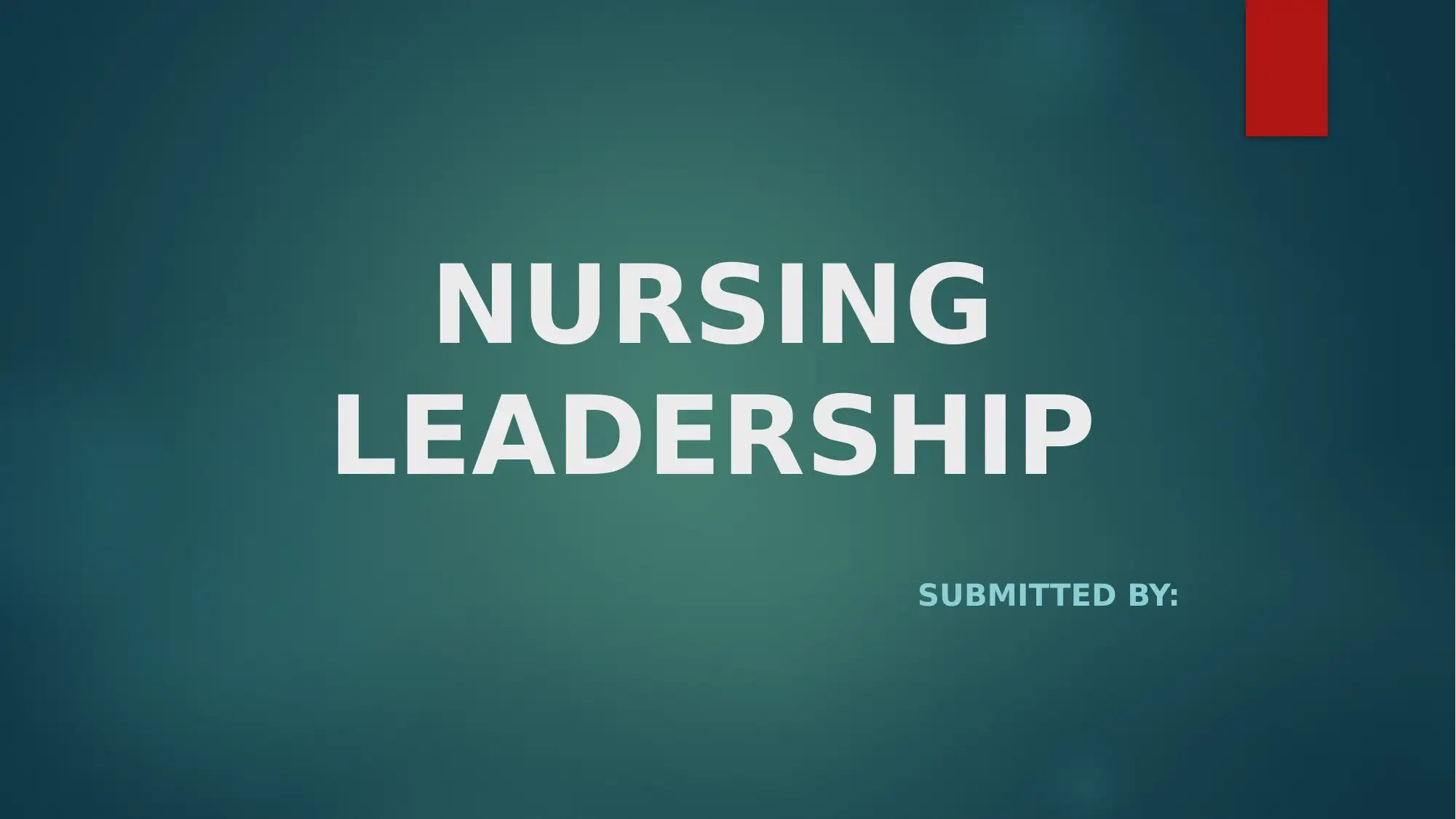
NURSING
LEADERSHIP
SUBMITTED BY:
LEADERSHIP
SUBMITTED BY:
Paraphrase This Document
Need a fresh take? Get an instant paraphrase of this document with our AI Paraphraser
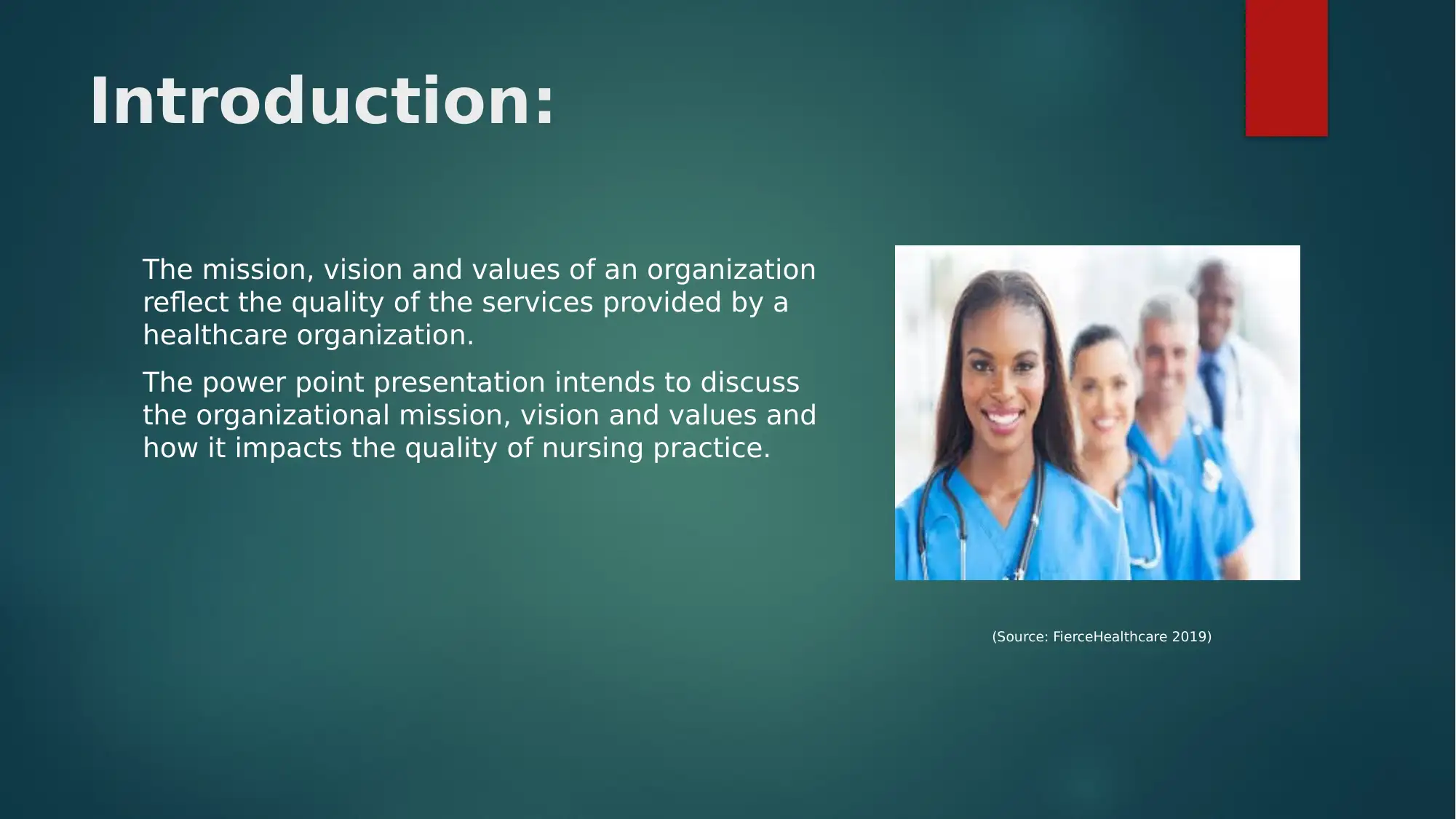
Introduction:
The mission, vision and values of an organization
reflect the quality of the services provided by a
healthcare organization.
The power point presentation intends to discuss
the organizational mission, vision and values and
how it impacts the quality of nursing practice.
(Source: FierceHealthcare 2019)
The mission, vision and values of an organization
reflect the quality of the services provided by a
healthcare organization.
The power point presentation intends to discuss
the organizational mission, vision and values and
how it impacts the quality of nursing practice.
(Source: FierceHealthcare 2019)
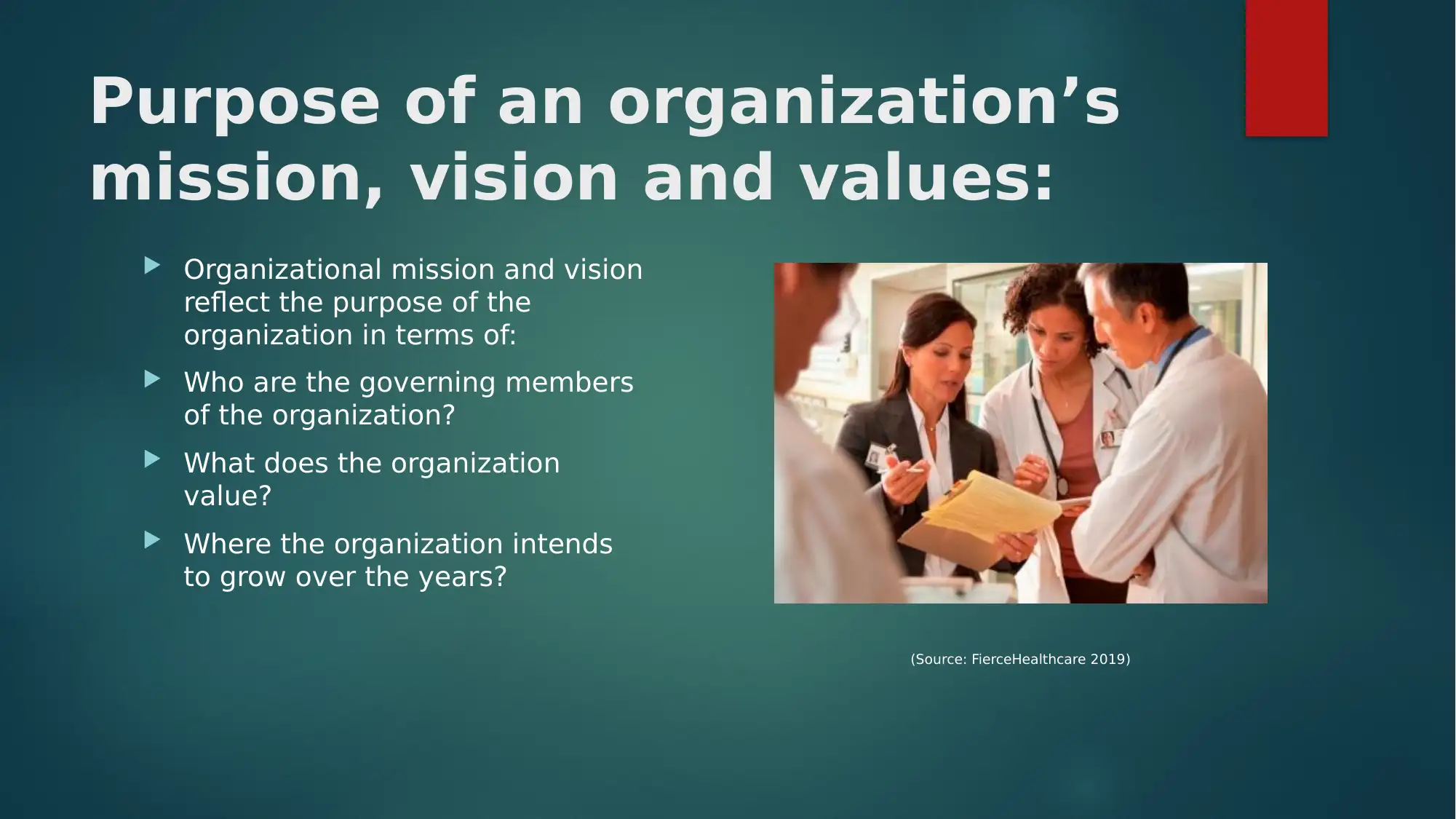
Purpose of an organization’s
mission, vision and values:
Organizational mission and vision
reflect the purpose of the
organization in terms of:
Who are the governing members
of the organization?
What does the organization
value?
Where the organization intends
to grow over the years?
(Source: FierceHealthcare 2019)
mission, vision and values:
Organizational mission and vision
reflect the purpose of the
organization in terms of:
Who are the governing members
of the organization?
What does the organization
value?
Where the organization intends
to grow over the years?
(Source: FierceHealthcare 2019)
⊘ This is a preview!⊘
Do you want full access?
Subscribe today to unlock all pages.

Trusted by 1+ million students worldwide
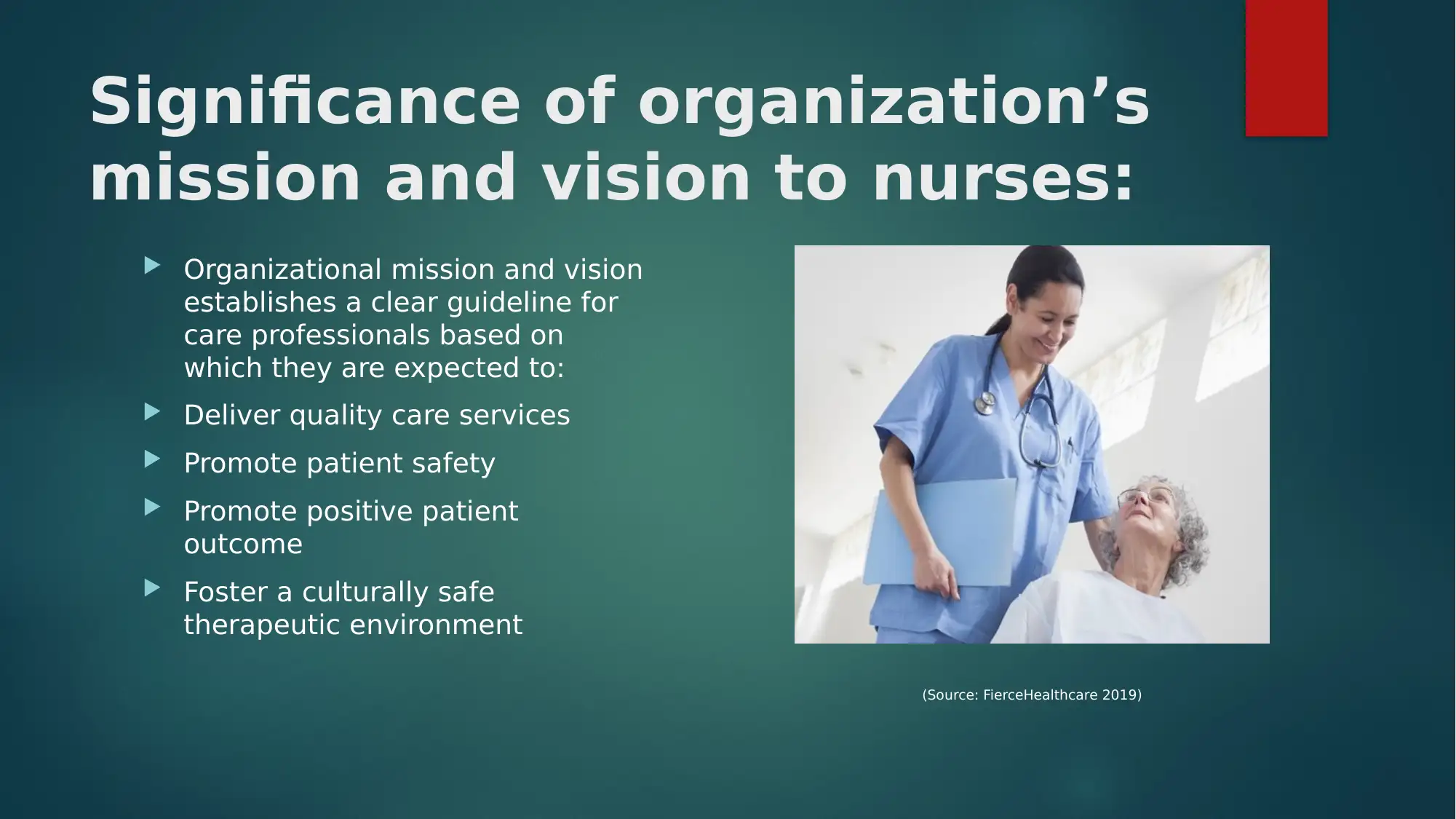
Significance of organization’s
mission and vision to nurses:
Organizational mission and vision
establishes a clear guideline for
care professionals based on
which they are expected to:
Deliver quality care services
Promote patient safety
Promote positive patient
outcome
Foster a culturally safe
therapeutic environment
(Source: FierceHealthcare 2019)
mission and vision to nurses:
Organizational mission and vision
establishes a clear guideline for
care professionals based on
which they are expected to:
Deliver quality care services
Promote patient safety
Promote positive patient
outcome
Foster a culturally safe
therapeutic environment
(Source: FierceHealthcare 2019)
Paraphrase This Document
Need a fresh take? Get an instant paraphrase of this document with our AI Paraphraser
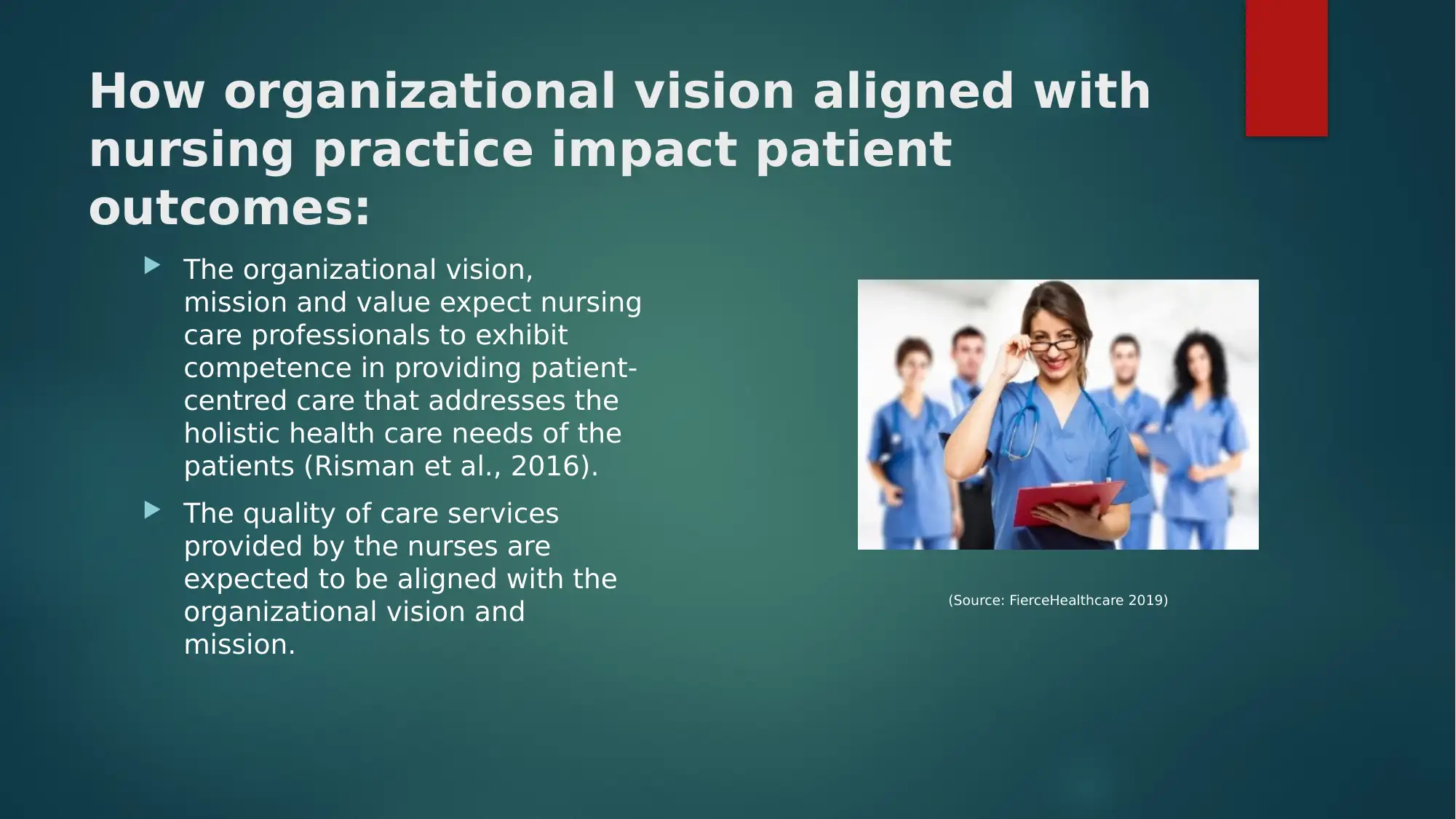
How organizational vision aligned with
nursing practice impact patient
outcomes:
The organizational vision,
mission and value expect nursing
care professionals to exhibit
competence in providing patient-
centred care that addresses the
holistic health care needs of the
patients (Risman et al., 2016).
The quality of care services
provided by the nurses are
expected to be aligned with the
organizational vision and
mission.
(Source: FierceHealthcare 2019)
nursing practice impact patient
outcomes:
The organizational vision,
mission and value expect nursing
care professionals to exhibit
competence in providing patient-
centred care that addresses the
holistic health care needs of the
patients (Risman et al., 2016).
The quality of care services
provided by the nurses are
expected to be aligned with the
organizational vision and
mission.
(Source: FierceHealthcare 2019)
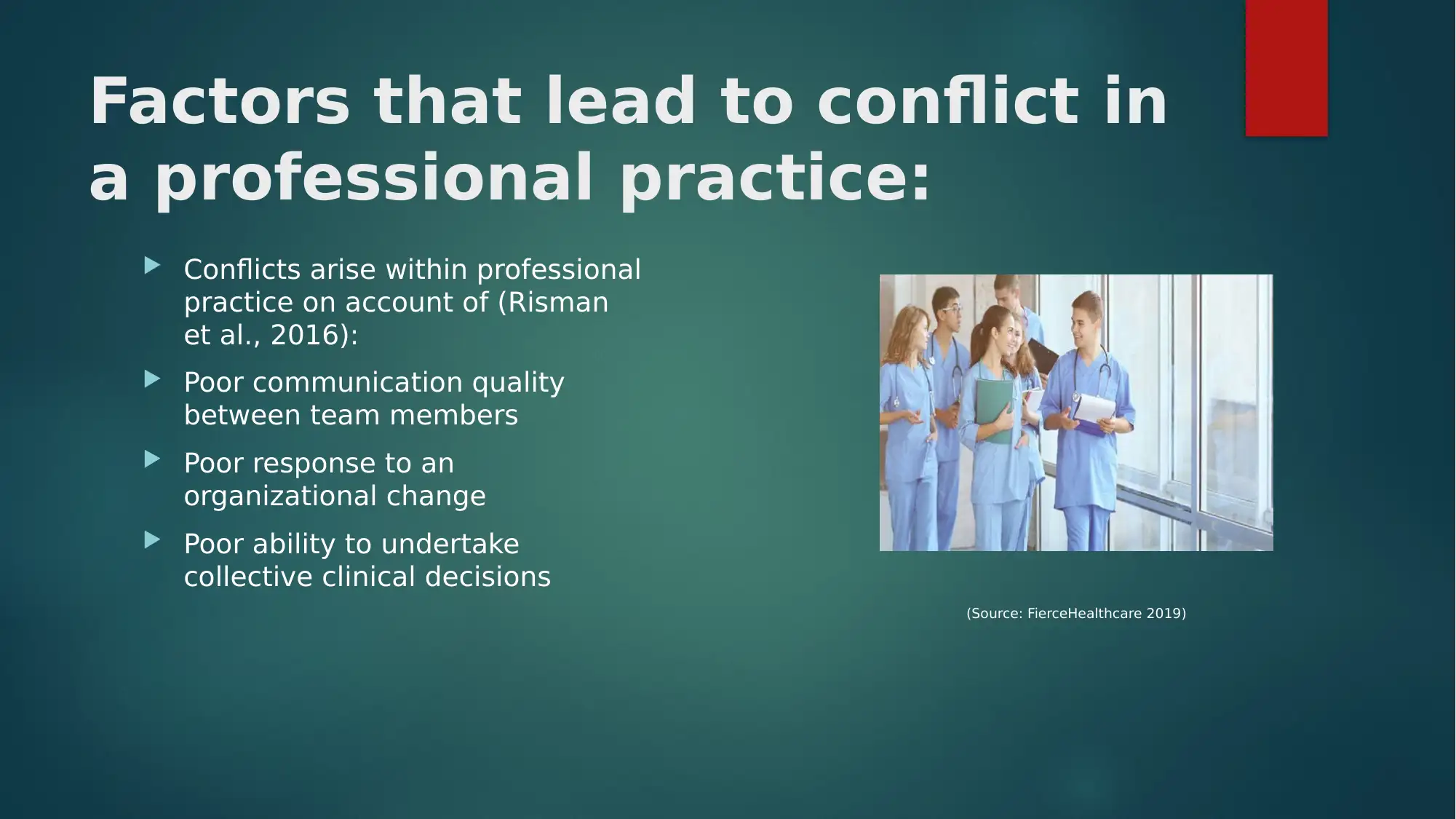
Factors that lead to conflict in
a professional practice:
Conflicts arise within professional
practice on account of (Risman
et al., 2016):
Poor communication quality
between team members
Poor response to an
organizational change
Poor ability to undertake
collective clinical decisions
(Source: FierceHealthcare 2019)
a professional practice:
Conflicts arise within professional
practice on account of (Risman
et al., 2016):
Poor communication quality
between team members
Poor response to an
organizational change
Poor ability to undertake
collective clinical decisions
(Source: FierceHealthcare 2019)
⊘ This is a preview!⊘
Do you want full access?
Subscribe today to unlock all pages.

Trusted by 1+ million students worldwide
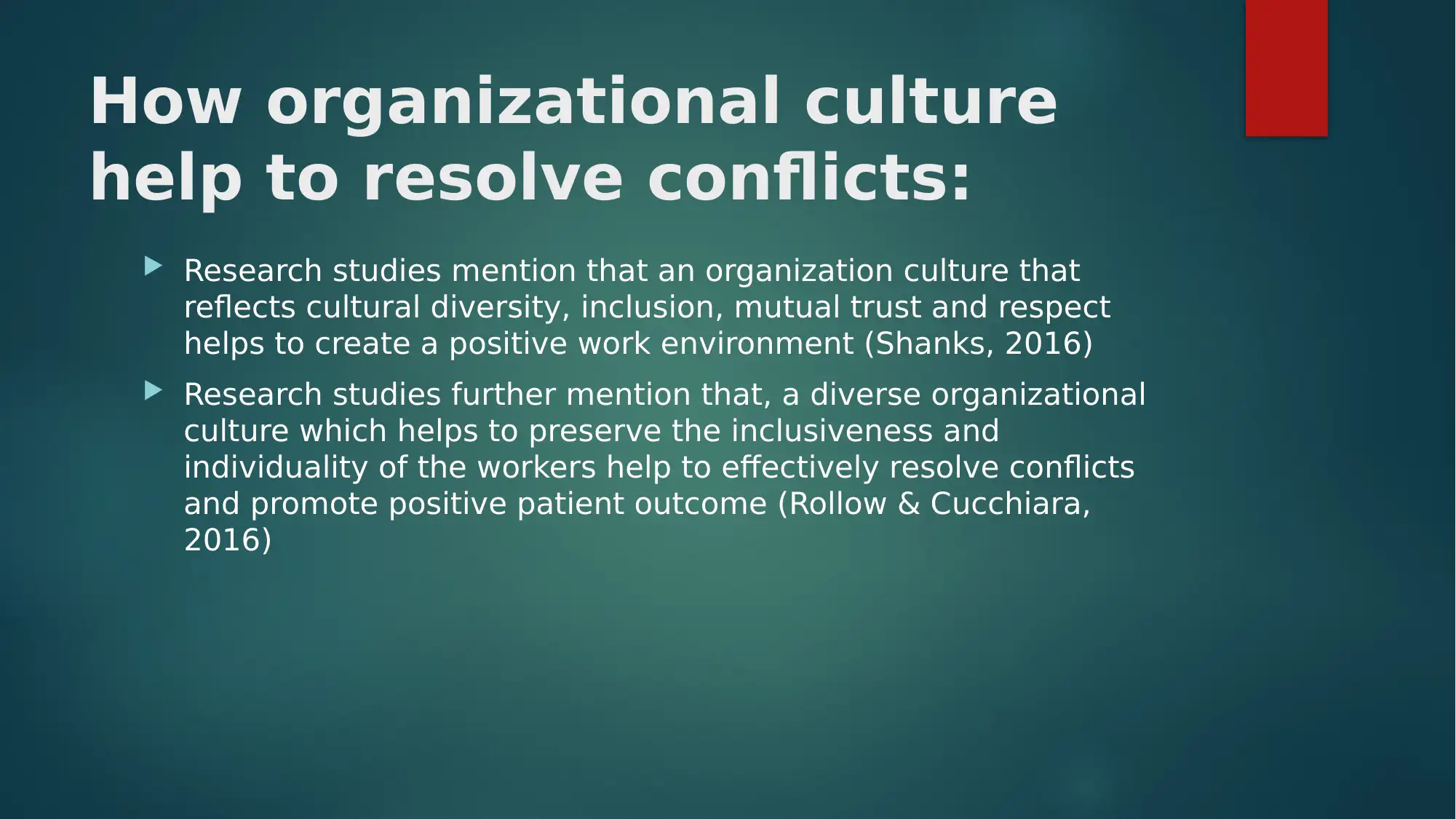
How organizational culture
help to resolve conflicts:
Research studies mention that an organization culture that
reflects cultural diversity, inclusion, mutual trust and respect
helps to create a positive work environment (Shanks, 2016)
Research studies further mention that, a diverse organizational
culture which helps to preserve the inclusiveness and
individuality of the workers help to effectively resolve conflicts
and promote positive patient outcome (Rollow & Cucchiara,
2016)
help to resolve conflicts:
Research studies mention that an organization culture that
reflects cultural diversity, inclusion, mutual trust and respect
helps to create a positive work environment (Shanks, 2016)
Research studies further mention that, a diverse organizational
culture which helps to preserve the inclusiveness and
individuality of the workers help to effectively resolve conflicts
and promote positive patient outcome (Rollow & Cucchiara,
2016)
Paraphrase This Document
Need a fresh take? Get an instant paraphrase of this document with our AI Paraphraser

Effective strategies for
resolving workplace conflict:
Effective strategies to resolve workplace conflict would include
the following (Shanks, 2016):
One on one session
Open discussion
Consideration of the grievance of both the parties
Effective communication
Negotiation
resolving workplace conflict:
Effective strategies to resolve workplace conflict would include
the following (Shanks, 2016):
One on one session
Open discussion
Consideration of the grievance of both the parties
Effective communication
Negotiation
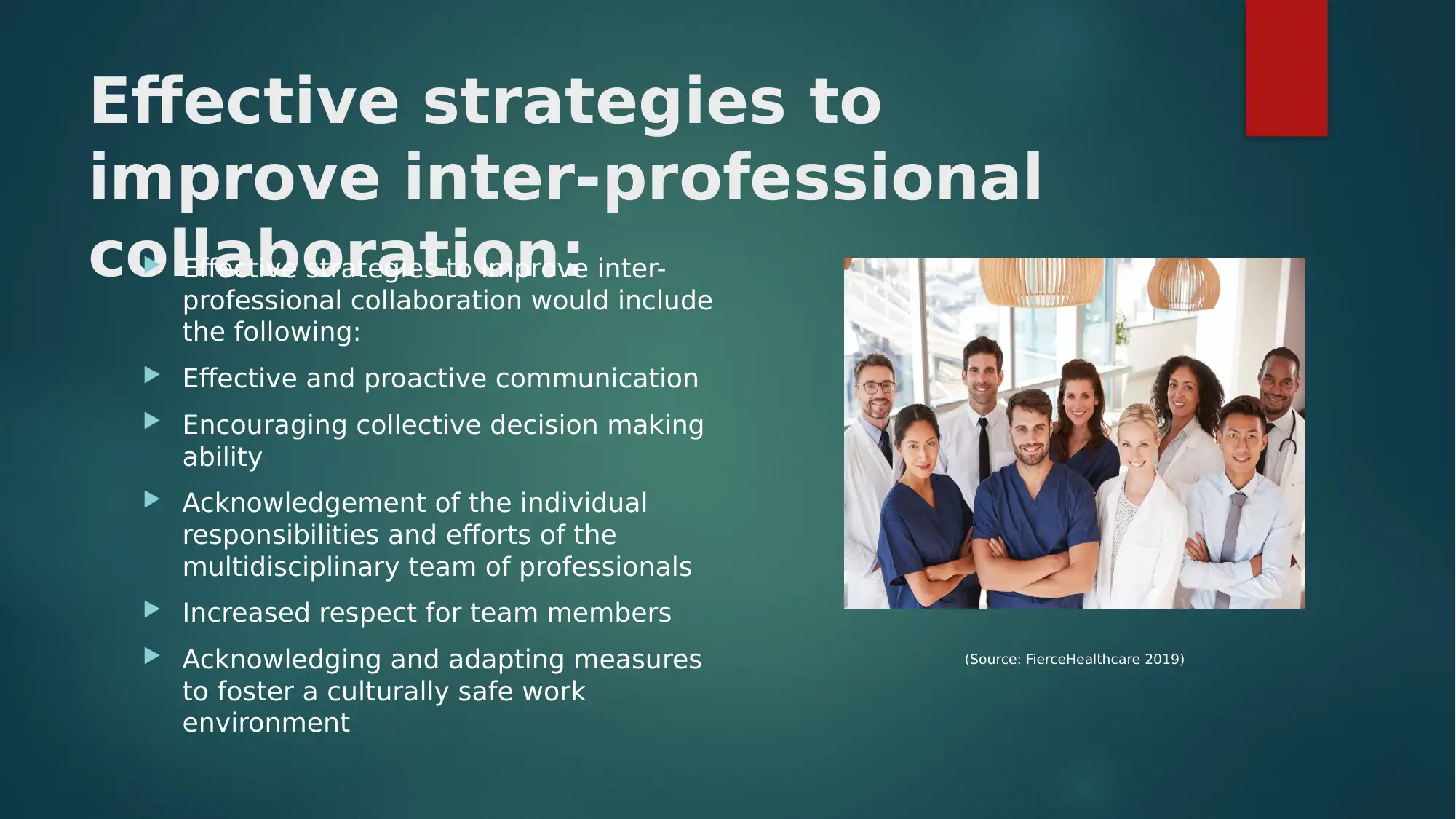
Effective strategies to
improve inter-professional
collaboration: Effective strategies to improve inter-
professional collaboration would include
the following:
Effective and proactive communication
Encouraging collective decision making
ability
Acknowledgement of the individual
responsibilities and efforts of the
multidisciplinary team of professionals
Increased respect for team members
Acknowledging and adapting measures
to foster a culturally safe work
environment
(Source: FierceHealthcare 2019)
improve inter-professional
collaboration: Effective strategies to improve inter-
professional collaboration would include
the following:
Effective and proactive communication
Encouraging collective decision making
ability
Acknowledgement of the individual
responsibilities and efforts of the
multidisciplinary team of professionals
Increased respect for team members
Acknowledging and adapting measures
to foster a culturally safe work
environment
(Source: FierceHealthcare 2019)
⊘ This is a preview!⊘
Do you want full access?
Subscribe today to unlock all pages.

Trusted by 1+ million students worldwide
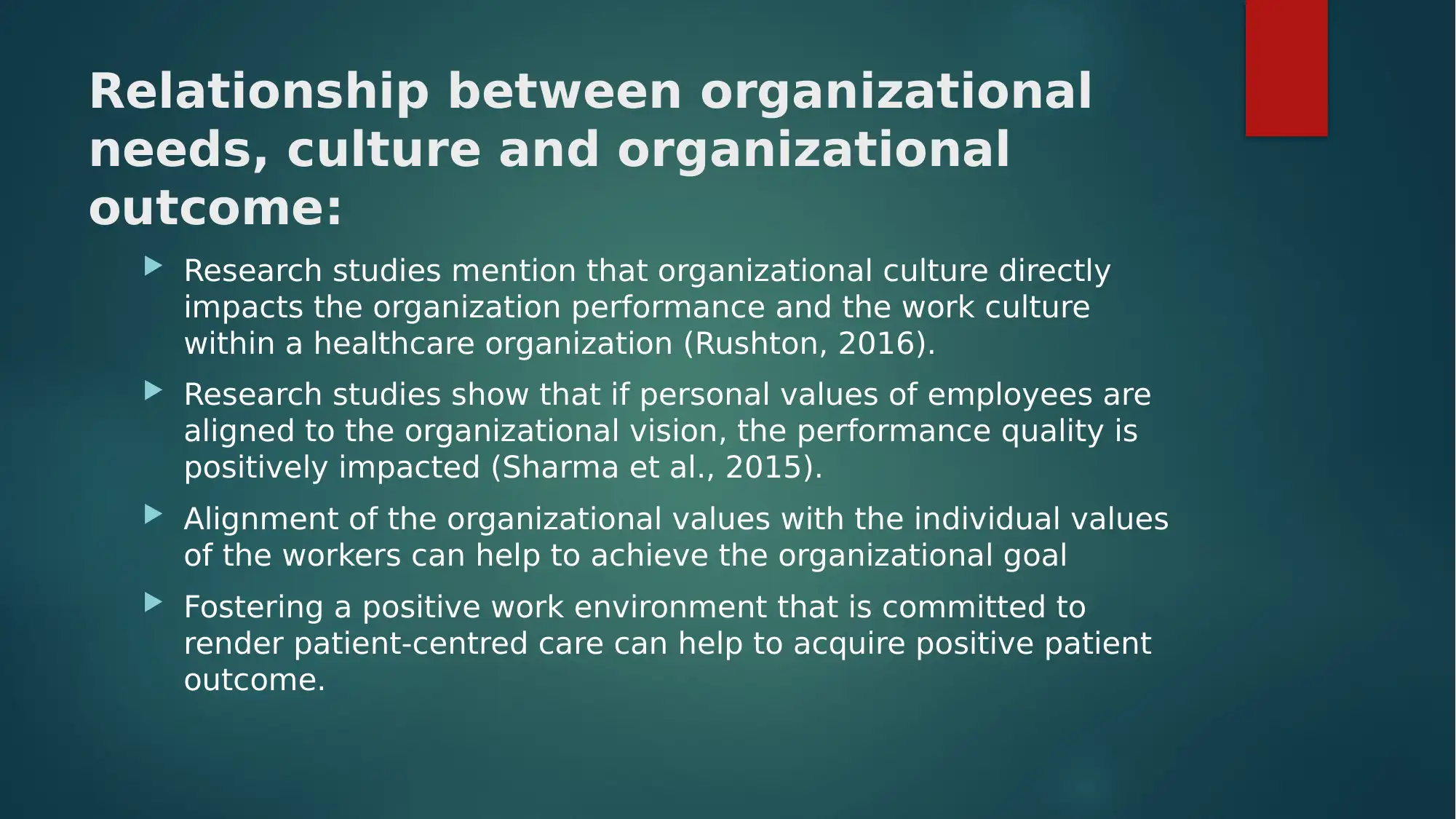
Relationship between organizational
needs, culture and organizational
outcome:
Research studies mention that organizational culture directly
impacts the organization performance and the work culture
within a healthcare organization (Rushton, 2016).
Research studies show that if personal values of employees are
aligned to the organizational vision, the performance quality is
positively impacted (Sharma et al., 2015).
Alignment of the organizational values with the individual values
of the workers can help to achieve the organizational goal
Fostering a positive work environment that is committed to
render patient-centred care can help to acquire positive patient
outcome.
needs, culture and organizational
outcome:
Research studies mention that organizational culture directly
impacts the organization performance and the work culture
within a healthcare organization (Rushton, 2016).
Research studies show that if personal values of employees are
aligned to the organizational vision, the performance quality is
positively impacted (Sharma et al., 2015).
Alignment of the organizational values with the individual values
of the workers can help to achieve the organizational goal
Fostering a positive work environment that is committed to
render patient-centred care can help to acquire positive patient
outcome.
Paraphrase This Document
Need a fresh take? Get an instant paraphrase of this document with our AI Paraphraser
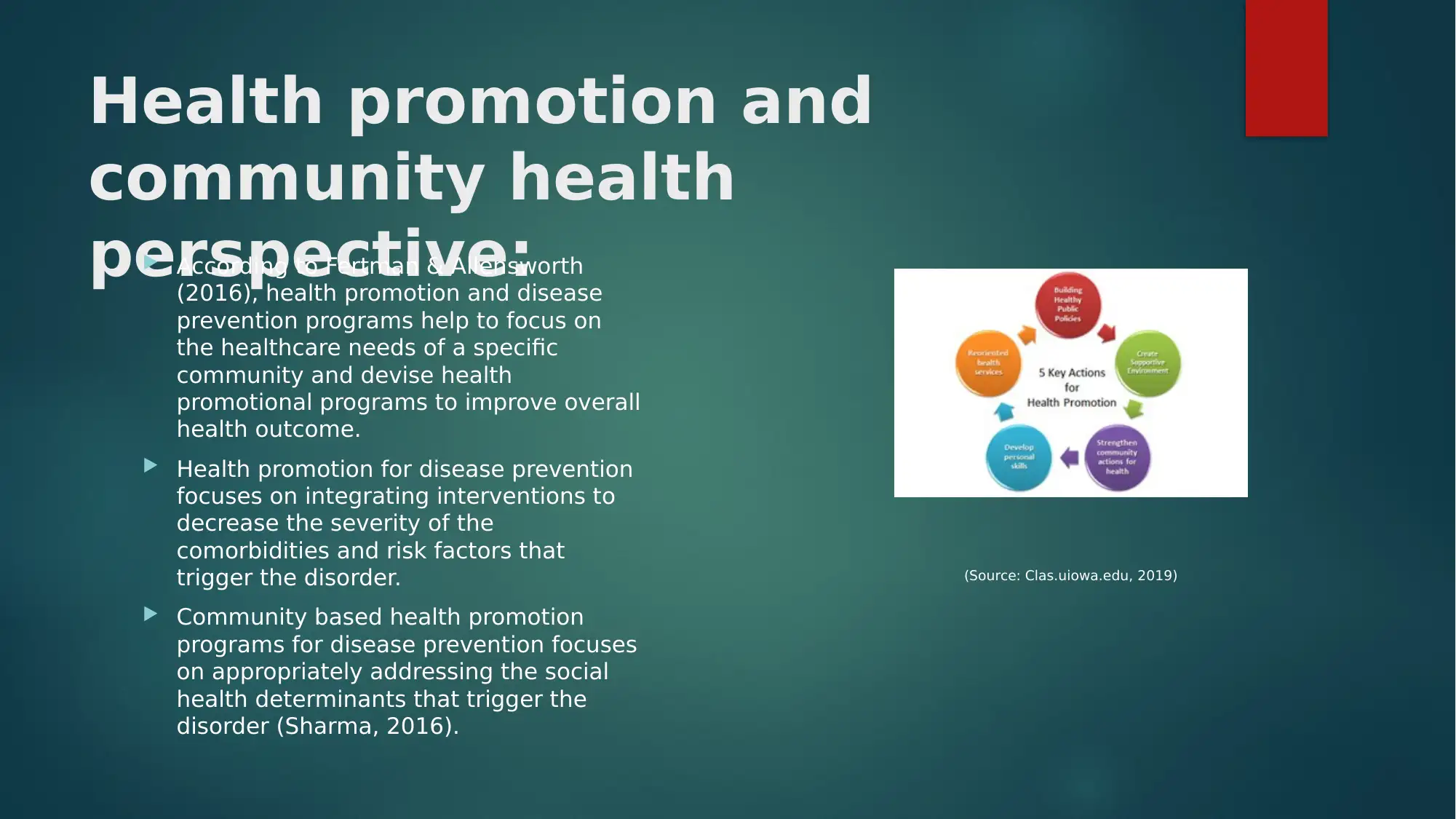
Health promotion and
community health
perspective: According to Fertman & Allensworth
(2016), health promotion and disease
prevention programs help to focus on
the healthcare needs of a specific
community and devise health
promotional programs to improve overall
health outcome.
Health promotion for disease prevention
focuses on integrating interventions to
decrease the severity of the
comorbidities and risk factors that
trigger the disorder.
Community based health promotion
programs for disease prevention focuses
on appropriately addressing the social
health determinants that trigger the
disorder (Sharma, 2016).
(Source: Clas.uiowa.edu, 2019)
community health
perspective: According to Fertman & Allensworth
(2016), health promotion and disease
prevention programs help to focus on
the healthcare needs of a specific
community and devise health
promotional programs to improve overall
health outcome.
Health promotion for disease prevention
focuses on integrating interventions to
decrease the severity of the
comorbidities and risk factors that
trigger the disorder.
Community based health promotion
programs for disease prevention focuses
on appropriately addressing the social
health determinants that trigger the
disorder (Sharma, 2016).
(Source: Clas.uiowa.edu, 2019)
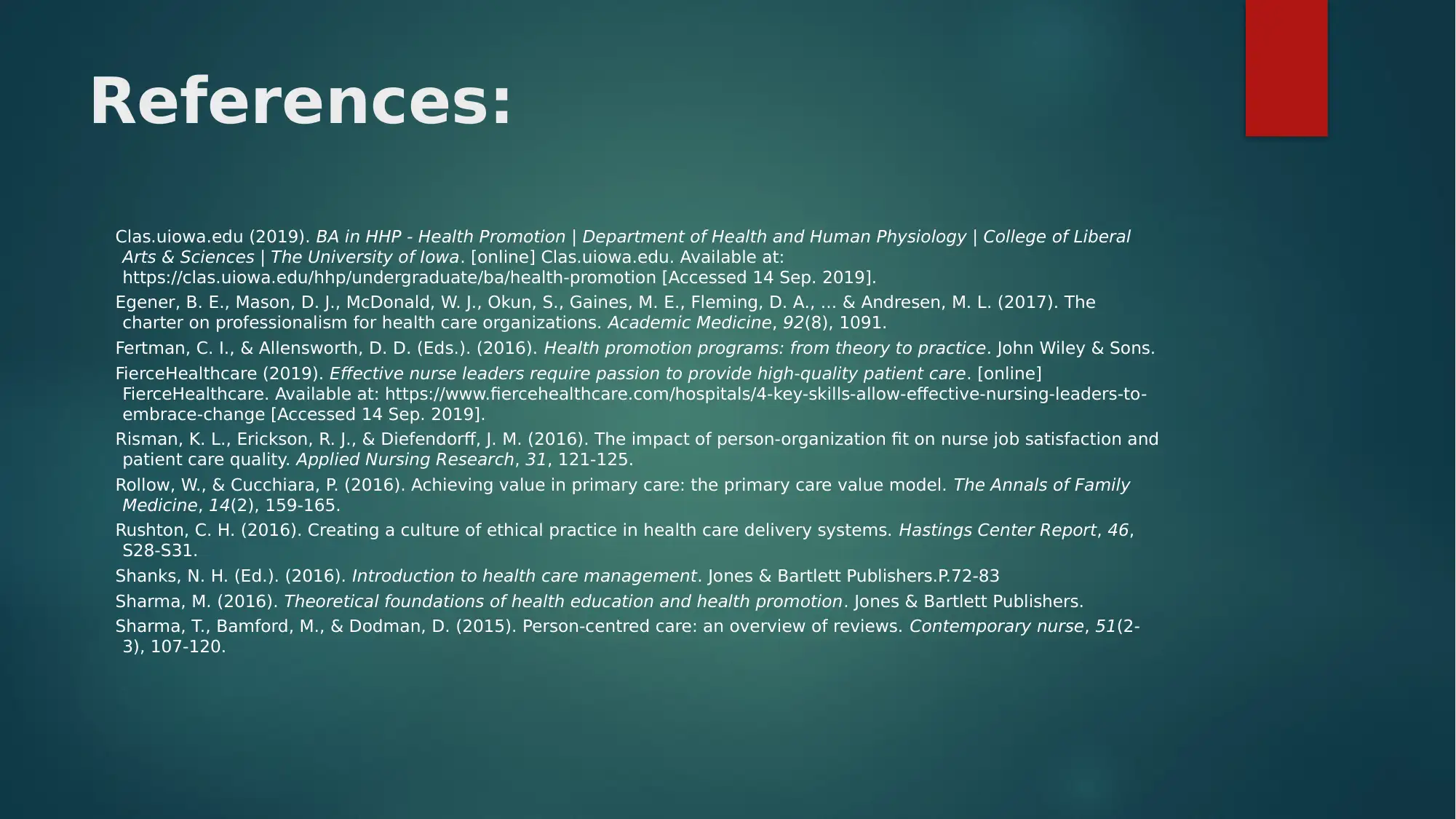
References:
Clas.uiowa.edu (2019). BA in HHP - Health Promotion | Department of Health and Human Physiology | College of Liberal
Arts & Sciences | The University of Iowa. [online] Clas.uiowa.edu. Available at:
https://clas.uiowa.edu/hhp/undergraduate/ba/health-promotion [Accessed 14 Sep. 2019].
Egener, B. E., Mason, D. J., McDonald, W. J., Okun, S., Gaines, M. E., Fleming, D. A., ... & Andresen, M. L. (2017). The
charter on professionalism for health care organizations. Academic Medicine, 92(8), 1091.
Fertman, C. I., & Allensworth, D. D. (Eds.). (2016). Health promotion programs: from theory to practice. John Wiley & Sons.
FierceHealthcare (2019). Effective nurse leaders require passion to provide high-quality patient care. [online]
FierceHealthcare. Available at: https://www.fiercehealthcare.com/hospitals/4-key-skills-allow-effective-nursing-leaders-to-
embrace-change [Accessed 14 Sep. 2019].
Risman, K. L., Erickson, R. J., & Diefendorff, J. M. (2016). The impact of person-organization fit on nurse job satisfaction and
patient care quality. Applied Nursing Research, 31, 121-125.
Rollow, W., & Cucchiara, P. (2016). Achieving value in primary care: the primary care value model. The Annals of Family
Medicine, 14(2), 159-165.
Rushton, C. H. (2016). Creating a culture of ethical practice in health care delivery systems. Hastings Center Report, 46,
S28-S31.
Shanks, N. H. (Ed.). (2016). Introduction to health care management. Jones & Bartlett Publishers.P.72-83
Sharma, M. (2016). Theoretical foundations of health education and health promotion. Jones & Bartlett Publishers.
Sharma, T., Bamford, M., & Dodman, D. (2015). Person-centred care: an overview of reviews. Contemporary nurse, 51(2-
3), 107-120.
Clas.uiowa.edu (2019). BA in HHP - Health Promotion | Department of Health and Human Physiology | College of Liberal
Arts & Sciences | The University of Iowa. [online] Clas.uiowa.edu. Available at:
https://clas.uiowa.edu/hhp/undergraduate/ba/health-promotion [Accessed 14 Sep. 2019].
Egener, B. E., Mason, D. J., McDonald, W. J., Okun, S., Gaines, M. E., Fleming, D. A., ... & Andresen, M. L. (2017). The
charter on professionalism for health care organizations. Academic Medicine, 92(8), 1091.
Fertman, C. I., & Allensworth, D. D. (Eds.). (2016). Health promotion programs: from theory to practice. John Wiley & Sons.
FierceHealthcare (2019). Effective nurse leaders require passion to provide high-quality patient care. [online]
FierceHealthcare. Available at: https://www.fiercehealthcare.com/hospitals/4-key-skills-allow-effective-nursing-leaders-to-
embrace-change [Accessed 14 Sep. 2019].
Risman, K. L., Erickson, R. J., & Diefendorff, J. M. (2016). The impact of person-organization fit on nurse job satisfaction and
patient care quality. Applied Nursing Research, 31, 121-125.
Rollow, W., & Cucchiara, P. (2016). Achieving value in primary care: the primary care value model. The Annals of Family
Medicine, 14(2), 159-165.
Rushton, C. H. (2016). Creating a culture of ethical practice in health care delivery systems. Hastings Center Report, 46,
S28-S31.
Shanks, N. H. (Ed.). (2016). Introduction to health care management. Jones & Bartlett Publishers.P.72-83
Sharma, M. (2016). Theoretical foundations of health education and health promotion. Jones & Bartlett Publishers.
Sharma, T., Bamford, M., & Dodman, D. (2015). Person-centred care: an overview of reviews. Contemporary nurse, 51(2-
3), 107-120.
⊘ This is a preview!⊘
Do you want full access?
Subscribe today to unlock all pages.

Trusted by 1+ million students worldwide
1 out of 13
Related Documents
Your All-in-One AI-Powered Toolkit for Academic Success.
+13062052269
info@desklib.com
Available 24*7 on WhatsApp / Email
![[object Object]](/_next/static/media/star-bottom.7253800d.svg)
Unlock your academic potential
Copyright © 2020–2025 A2Z Services. All Rights Reserved. Developed and managed by ZUCOL.





